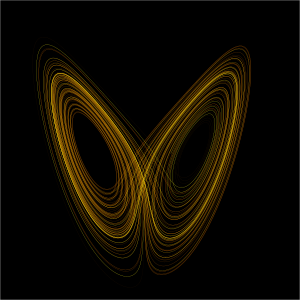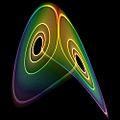Lorenz attractor facts for kids
The Lorenz attractor is a fascinating pattern found in mathematics. It's like a special drawing that shows how things can change in a very complex way. It's also called the Lorenz system.
A scientist named Edward N. Lorenz created the mathematical rules, or "equations," for this system. He was trying to make a simpler mathematical model to understand how air moves in the Earth's atmosphere, which is called atmospheric convection. The special equations he used are known as the Lorenz equations.
These equations are famous because they can create "chaotic" solutions. This means that even a tiny change at the beginning can lead to very different results later on. When you plot these chaotic solutions, they often look like a butterfly or the number eight.
The idea of the butterfly effect is closely linked to the Lorenz attractor. Edward Lorenz first talked about the "butterfly effect" in a speech he gave in 1972.
Contents
What is the Lorenz Attractor?
The Lorenz attractor is a set of mathematical rules that describe how a system changes over time. Imagine you have a set of instructions that tell you where a point should move next. If these instructions are the Lorenz equations, the path the point takes will eventually form a specific, beautiful shape. This shape is the Lorenz attractor.
Edward Lorenz and Weather Prediction
Edward Lorenz was a meteorologist, which means he studied the weather. In the 1960s, he was using computers to predict weather patterns. He noticed something strange: if he rounded off a number in his weather model by just a tiny bit, the weather prediction would end up completely different! This showed him that even very small changes could have huge, unpredictable effects in complex systems like the weather.
The Butterfly Effect Explained
The "butterfly effect" is a popular way to explain this idea of chaos. It suggests that a tiny event, like a butterfly flapping its wings in Brazil, could theoretically cause a hurricane in Texas weeks later. This doesn't mean a butterfly actually causes a hurricane. Instead, it means that in a chaotic system, very small changes in the starting conditions can lead to massive and unpredictable differences in the future. The Lorenz attractor is a perfect example of this.
How it Looks: The Butterfly Shape
When you plot the solutions of the Lorenz equations on a graph, they don't just go off in a straight line or a simple circle. Instead, they swirl around two different points, never quite repeating the exact same path. This creates a double-lobed shape that looks a lot like a butterfly's wings or the number eight. Even though the path is chaotic, it always stays within this specific butterfly-like region.
Images for kids
-
A recreation of Lorenz's results created on Mathematica. Points above the red line correspond to the system switching lobes.
-
A solution in the Lorenz attractor rendered as a metal wire to show direction and 3D structure.
See also
 In Spanish: Atractor de Lorenz para niños
In Spanish: Atractor de Lorenz para niños










